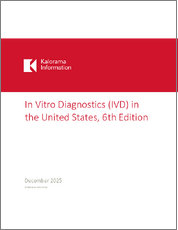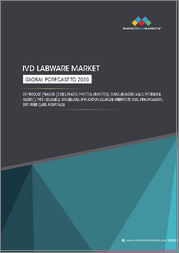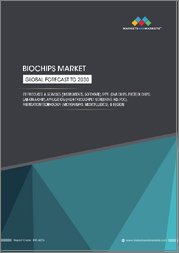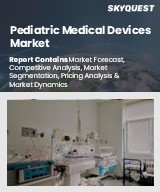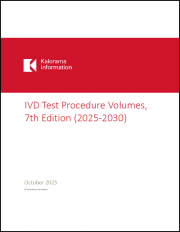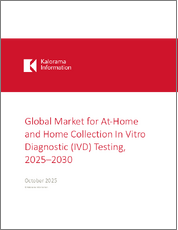
|
시장보고서
상품코드
1500103
세계의 차세대 체외 진단 시장 : 세계 산업 규모, 동향, 기회, 예측, 유형별, 제품별, 용도별, 최종 사용자별, 지역별, 경쟁별(2019-2029년)Next-Generation In-vitro Diagnostics Market - Global Industry Size, Share, Trends, Opportunity, and Forecast, Segmented By Type, By Product, By Application, By End User, By Region and Competition, 2019-2029F |
||||||
차세대 체외 진단 시장 규모는 2023년에 847억 4,000만 달러로 평가되었고 2029년까지 복합 연간 성장률(CAGR) 8.21%를 나타낼 전망이며 예측 기간 중에 꾸준한 성장이 예측되고 있습니다.
차세대 체외 진단(IVD)은 비침습적 진단 검사에 사용되는 최첨단 혁신적인 진단 기술입니다. 이러한 진보된 진단 도구는 다양한 질병 및 상태의 검출 및 모니터링에서 정확성, 효능 및 신뢰성을 향상시켜 진단 분야에서 큰 발전을 이루고 있습니다. 제품 혁신과 차세대 IVD 기술의 새로운 응용을 탐구하기 위한 투자와 개발 증가로 성장이 더욱 강화되고 있습니다. 차세대 체외진단시장에 있어서는 신흥경제 국가에서 신흥경제의 발전이 가져오는 산업적 영향은 큽니다. 이 지역에서는 더 나은 건강 관리 시스템, 고품질 진단제에 대한 접근성 향상, 질병 치료를 위한 최첨단 기술의 도입에 대한 수요가 증가하고 있습니다. 규제상황과 상환정책은 세계 차세대 체외진단용 의약품의 개발과 보급에 중요한 역할을 하고 있습니다. IVD 기술을 표준 치료에 원활하게 통합할 수 있는 유리한 규제와 상환 구조를 제공함으로써 시장 성장을 크게 늘릴 수 있습니다.
| 시장 개요 | |
|---|---|
| 예측 기간 | 2025-2029 |
| 시장 규모 : 2023년 | 847억 4,000만 달러 |
| 시장 규모 : 2029년 | 1,354억 6,000만 달러 |
| 복합 연간 성장률(CAGR): 2024년-2029년 | 8.21% |
| 급성장 부문 | 분자진단제 |
| 최대 시장 | 북미 |
시장 성장 촉진요인
차세대 체외 진단의 기술 진보
포인트 오브 케어 검사 수요 증가
만성 질환의 유병률 증가
조기 및 정확한 질병 진단에 대한 수요
주요 시장 과제
높은 개발 비용
통합의 복잡성
주요 시장 동향
업계 내 전략적 제휴와 합병
목차
제1장 개요
제2장 조사 방법
제3장 주요 요약
제4장 고객의 목소리
제5장 세계 차세대 체외 진단 시장 전망
- 시장 규모와 예측
- 금액별
- 시장 점유율,예측
- 유형별(코어 랩 진단, POC 테스트, 분자진단, 기타)
- 제품별(소모품, 기기, 소프트웨어)
- 용도별(종양학/암, 감염증, 당뇨병, 심장병학, 기타)
- 최종 사용자별(병원 및 진료소, 진단 실험실, 학술연구 기관, 기타)
- 지역별
- 기업별(2023)
- 시장 맵
제6장 북미의 차세대 체외 진단 시장 전망
- 시장 규모와 예측
- 금액별
- 시장 점유율,예측
- 유형별
- 제품별
- 용도별
- 최종 사용자별
- 국가별
- 북미: 국가별 분석
- 미국
- 캐나다
- 멕시코
제7장 유럽의 차세대 체외 진단 시장 전망
- 시장 규모와 예측
- 금액별
- 시장 점유율,예측
- 유형별
- 제품별
- 용도별
- 최종 사용자별
- 국가별
- 유럽: 국가별 분석
- 프랑스
- 독일
- 영국
- 이탈리아
- 스페인
제8장 아시아태평양의 차세대 체외 진단 시장 전망
- 시장 규모와 예측
- 금액별
- 시장 점유율,예측
- 유형별
- 제품별
- 용도별
- 최종 사용자별
- 국가별
- 아시아태평양: 국가별 분석
- 인도
- 일본
- 한국
- 호주
- 한국
제9장 남미의 차세대 체외 진단 시장 전망
- 시장 규모와 예측
- 금액별
- 시장 점유율,예측
- 유형별
- 제품별
- 용도별
- 최종 사용자별
- 국가별
- 남미 : 국가별 분석
- 브라질
- 콜롬비아
- 아르헨티나
제10장 중동 및 아프리카의 차세대 체외 진단 시장 전망
- 시장 규모와 예측
- 금액별
- 시장 점유율,예측
- 유형별
- 제품별
- 용도별
- 최종 사용자별
- 국가별
- 중동 및 아프리카: 국가별 분석
- 남아프리카
- 사우디아라비아
- 아랍에미리트(UAE)
제11장 시장 역학
- 성장 촉진요인
- 과제
제12장 시장 동향과 발전
- 최근 동향
- 합병과 인수
- 제품상시
제13장 세계 차세대 체외 진단 시장 : SWOT 분석
제14장 Porter's Five Forces 분석
- 업계 내 경쟁
- 신규 진입의 가능성
- 공급자의 힘
- 고객의 힘
- 대체품의 위협
제15장 경쟁 구도
- Thermo Fisher Scientific Inc.
- Becton, Dickinson, and Company
- Qiagen GmbH
- Illumina Inc.
- Beckman Coulter, Inc.
- Invivoscribe, Inc.
- Sysmex Corporation
- bioMerieux SA
- VWR International, LLC.
- Danaher Corporation
제16장 전략적 제안
제17장 기업 소개와 면책사항
BJH 24.07.04Global Next-Generation In-vitro Diagnostics Market was valued at USD 84.74 Billion in 2023 and is anticipated to project steady growth in the forecast period with a CAGR of 8.21% through 2029. IVDs, or Next-Generation In-Vitro Diagnostics, are cutting-edge and innovative diagnostic technologies that are used for non-invasive diagnostic testing. These advanced diagnostic tools are a major development in the field of diagnostics, providing improved precision, effectiveness, and dependability in the detection and monitoring of a variety of diseases and conditions. The growth is further augmented by increasing investment and development to innovate products and explore new applications of next generation IVD techniques. The industrial implications for the development of emerging economies in developing countries, are significant for the next generation in vitro diagnostics market. These regions are facing a growing demand for better healthcare systems, better access to quality diagnostics and the adoption of cutting-edge technologies to treat diseases. The regulatory landscape and reimbursement policies play a significant role in the development and uptake of next generation IVD technologies around the world. Providing favorable regulations and reimbursement structures that enable the smooth integration of IVD technologies into the standard of care can significantly increase market growth.
| Market Overview | |
|---|---|
| Forecast Period | 2025-2029 |
| Market Size 2023 | USD 84.74 Billion |
| Market Size 2029 | USD 135.46 Billion |
| CAGR 2024-2029 | 8.21% |
| Fastest Growing Segment | Molecular Diagnostics |
| Largest Market | North America |
Key Market Drivers
Technological Advancements in Next-Generation In-vitro Diagnostics
IVD has undergone a significant transformation due to the development of cutting-edge technologies, such as genomics, proteomics, and molecular diagnostic techniques. These advances, including NGS (Next Generation Sequencing), digital PCR (PCR), and other pioneering technologies, have significantly improved the accuracy, sensitivity, and effectiveness of diagnostic testing. Molecular diagnostic techniques were becoming progressively advanced, enabling the detection of DNA and RNA for the purpose of diagnosing infections, genetic diseases, and various malignancies. NGS (Next Generation Sequencing) technology has revolutionized the field of genetic testing, allowing for rapid and accurate sequencing of both DNA and RNA. This technology has enabled the analysis of intricate genetic variations, as well as providing valuable information for the development of personalized medicine and the profiling of cancer. The utilization of IVD technologies, such as Wearable Devices (WFDs) and Home Testing Kits (HTKs), allows for the remote monitoring of patient health conditions. This allows for the continuous monitoring of chronic conditions and facilitates the remote management of disease. Patients can monitor their health parameters and transfer data to healthcare providers to initiate timely interventions and modify treatment plans. Liquid biopsy techniques have advanced to the point where they can be used to detect circulating tumor cells in blood samples without the need for an invasive procedure, as well as other biomarkers that can provide valuable information for the diagnosis and monitoring of cancer. Biosensors and nanotechnologies have enabled the development of diagnostic tools that are highly sensitive and precise, allowing for the early detection and quantification of biomarkers. Improvements in data interchangeability and connectivity standards enabled IVD devices to be seamlessly integrated into healthcare information systems, thereby improving data interchange and patient care coordination. To sum up, in vitro diagnostics is revolutionizing the healthcare system by increasing precision and accuracy, early detection, personalized medicine, remote and point of care testing, data driven healthcare, streamlining workflow, remote monitoring, and disease management. These innovations have the potential to improve patient outcomes, improve resource efficiency, and revolutionize healthcare delivery. This factor will pace up the demand of Global Next Generation In-vitro Diagnostics Market.
Rising Demand of Point-of-Care Testing
POCT (point-of-care testing) is an essential element of IVD diagnostics. POCT refers to diagnostic tests conducted at or near the patient's point of care, such as a physician's office, a clinic, or the patient's bedside, as opposed to samples being sent to a laboratory for analysis. POCT offers several advantages, one of which is its ability to provide results in real-time, often in as little as a few minutes. This expedited response allows healthcare professionals to make timely treatment decisions and enhance patient care. With fast and local testing, POCT makes it easier to spot and diagnose illnesses early, so you can get treatment as soon as possible and see better results for your patients. POCT allows healthcare professionals to always keep an eye on patient's health, which makes it especially useful for chronic disease treatment and therapeutic monitoring. POCT eliminates the need to send samples to a remote laboratory and wait for the results, thus reducing the likelihood of sample degradation and diagnostic delays. POCT devices are typically easy to use and require minimal instruction, making the testing process easier for healthcare professionals. POCT devices may incur higher initial out-of-pocket expenses, however, the overall cost effectiveness of such tests can be considerable, particularly when considering the reduction of hospital stays and improved use of resources. POCT can be useful in cases like an outbreak of an infectious disease, as it can help quickly identify who is at risk and put in place the right measures to keep them safe. This factor will accelerate the demand of Global Next Generation In-vitro Diagnostics Market.
Growing Prevalence of Chronic Diseases
Chronic diseases have been on the rise for the past several decades and remain a major global health issue. These chronic conditions, also referred to as NCDs (non-communicable diseases), are characterized by a slow progression of symptoms and are usually caused by complex underlying conditions. Common types of NCDs include cardiovascular disease (heart disease, stroke, diabetes, cancer), chronic respiratory disease (such as COPD) and obesity. According to American Cancer Society, around 19.3 million people were diagnosed with cancer in 2020, and nearly 10.0 million people died of it around the World. Breast cancer is now the most common type of cancer, with over 2.3 million people diagnosed each year. Lung cancer is second with 11.7%, followed by colorectal with 10.0%, prostate with 7.3%, and stomach with 5.6%. Chronic diseases are caused by a variety of factors, but the most common are poor diet, poor physical activity, tobacco consumption, and excessive consumption of alcohol. Unfortunately, these lifestyle choices are common in many countries and contribute to the onset of chronic diseases such as obesity, diabetes, and cardiovascular disease. Urbanization has been associated with a decrease in physical activity and an increase in reliance on motorized transportation, both of which have been linked to an increased risk of chronic diseases. Chronic diseases can be caused by a variety of environmental factors, including atmospheric pollution, exposure to toxic substances, and certain workplace risks. Certain chronic diseases may be caused by genetic factors, and those with a familial history of certain diseases may be more susceptible to developing them. This factor will help in the growth of Global Next-Generation In-vitro Diagnostics Market.
Demand for Early & Accurate Disease Diagnosis
The demand for early and accurate disease diagnosis is driving an increase in the global demand for next-generation in-vitro diagnostics (IVD). Timely and precise diagnosis is crucial for effective disease management, enabling healthcare providers to initiate appropriate treatments promptly and monitor patient response. Next-generation IVD technologies offer significant advancements over traditional diagnostic methods, providing greater sensitivity, specificity, and speed in detecting a wide range of diseases and conditions. These innovative diagnostics encompass various platforms, including molecular diagnostics, immunoassays, and point-of-care testing, each offering unique advantages in terms of versatility, automation, and portability. Next-generation IVDs facilitate the detection of biomarkers and genetic markers associated with specific diseases, enabling personalized and targeted therapies. As healthcare systems worldwide increasingly prioritize early disease detection and intervention to improve patient outcomes and reduce healthcare costs, the demand for next-generation IVDs continues to grow. Pharmaceutical companies, diagnostic manufacturers, and research institutions are investing in the development of innovative diagnostic technologies to meet this demand, driving market expansion and technological innovation in the field of in-vitro diagnostics. The rising demand for early and accurate disease diagnosis underscores the critical role of next-generation IVDs in advancing healthcare delivery and improving patient care globally.
Key Market Challenges
High Development Costs
The high development costs associated with next-generation in-vitro diagnostics (IVD) are contributing to a decrease in demand globally. Developing innovative diagnostic technologies requires substantial investment in research, development, regulatory approval, and commercialization. The complex nature of next-generation IVD platforms, coupled with stringent regulatory requirements and the need for extensive clinical validation, results in significant upfront costs and prolonged development timelines. These high development costs pose a barrier to entry for smaller companies and startups, limiting the diversity of players in the market and constraining competition. The high cost of next-generation IVD technologies may deter healthcare providers and institutions from adopting these advanced diagnostics, particularly in resource-limited settings where budget constraints are more pronounced. Consequently, the limited accessibility and affordability of next-generation IVD platforms hinder their widespread adoption and utilization, diminishing overall demand. Despite their potential to improve patient outcomes and healthcare delivery, the high development costs associated with next-generation IVD technologies present a challenge to market growth and innovation in the field. Addressing these cost barriers through collaborative funding initiatives, streamlined regulatory pathways, and innovative financing models is essential to stimulate demand and drive the advancement of next-generation in-vitro diagnostics on a global scale.
Complexity of Integration
The complexity of integration poses a significant challenge to the widespread adoption of next-generation in-vitro diagnostics (IVD) globally, thereby decreasing demand. Next-generation IVD technologies often involve intricate systems and platforms that require seamless integration with existing healthcare infrastructures, including laboratory information systems (LIS), electronic health records (EHR), and hospital networks. However, the integration process can be complex and time-consuming, involving compatibility issues, data interoperability challenges, and customization requirements tailored to specific healthcare settings. The deployment of next-generation IVD systems may necessitate extensive training for healthcare personnel to effectively operate and interpret results, further adding to the complexity of implementation. These integration challenges present barriers to adoption for healthcare providers, particularly in resource-constrained settings where infrastructure and technical expertise may be limited. Consequently, the perceived complexity of integration hinders the uptake of next-generation IVD technologies, diminishing demand globally. Addressing these integration challenges requires collaborative efforts between technology developers, healthcare providers, and regulatory agencies to streamline interoperability standards, enhance user-friendly interfaces, and provide comprehensive training and support. By mitigating the complexity of integration, stakeholders can accelerate the adoption of next-generation in-vitro diagnostics, unlocking their full potential to improve patient care and healthcare delivery worldwide.
Key Market Trends
The global increase in healthcare expenditure is significantly boosting the demand for next-generation in-vitro diagnostics (IVD) technologies. As healthcare systems worldwide allocate more resources to improve patient care and enhance healthcare outcomes, there is a growing recognition of the critical role that advanced diagnostics play in achieving these objectives. Next-generation IVD technologies offer several advantages over traditional diagnostic methods, including greater accuracy, speed, and efficiency in detecting diseases and guiding treatment decisions. These innovations empower healthcare providers to deliver more personalized and targeted care, optimizing patient outcomes while minimizing healthcare costs associated with misdiagnosis, ineffective treatments, and prolonged hospital stays. The rising prevalence of chronic diseases, aging populations, and infectious outbreaks underscores the need for robust diagnostic solutions capable of rapidly and accurately identifying a diverse range of medical conditions. Consequently, healthcare stakeholders are increasingly investing in next-generation IVD platforms, driving market growth and technological innovation in the field. Pharmaceutical companies, diagnostic manufacturers, and research institutions are collaborating to develop novel diagnostic assays, platforms, and technologies to meet the growing demand for advanced diagnostic solutions. Overall, the surge in healthcare expenditure globally is fueling the demand for next-generation in-vitro diagnostics, reshaping healthcare delivery and paving the way for more effective and efficient patient care.
Strategic Collaborations & Mergers Within the Industry
The increase in strategic collaborations and mergers within the healthcare industry is playing a significant role in driving up the demand for next-generation in-vitro diagnostics (IVD) globally. Collaborations between pharmaceutical companies, diagnostic manufacturers, research institutions, and technology firms are fostering synergies that accelerate innovation and drive the development of advanced diagnostic solutions. These partnerships enable the pooling of resources, expertise, and technology platforms, facilitating the rapid development and commercialization of next-generation IVD technologies. Strategic mergers and acquisitions within the industry are leading to the consolidation of key players, creating economies of scale and enhancing market reach. As a result, companies are better positioned to invest in research and development, expand their product portfolios, and address emerging market needs. Strategic collaborations and mergers enable companies to leverage complementary capabilities and access new markets, driving market growth and increasing the adoption of next-generation IVD technologies worldwide. The trend towards increased collaboration and consolidation within the healthcare industry is fueling demand for advanced diagnostic solutions, reshaping the landscape of in-vitro diagnostics, and driving innovation to address unmet medical needs globally.
Segmental Insights
Type Insights
Based on Type, Molecular Diagnostics have emerged as fastest growing segment in the Global Next-Generation In-vitro Diagnostics Market in 2023. With its high sensitivity and accuracy, coupled with the ability to detect and quantify multiple diseases, molecular diagnostics are revolutionizing personalized medicine and transforming the way we manage a plethora of health conditions. This segment's dominance is driven by continuous technological advancements, which have further enhanced the capabilities of these diagnostic tools. The increased prevalence of infectious and chronic diseases has amplified the need for accurate and timely disease detection. The growing demand for precision medicine, which focuses on tailoring medical treatments based on an individual's unique genetic makeup, has further propelled the adoption of molecular diagnostics. As a result, this innovative approach to diagnostics is paving the way for more targeted and effective healthcare interventions, ultimately improving patient outcomes and quality of life.
Product Insights
Based on Product, Consumables have emerged as the dominating segment in the Global Next-Generation In-vitro Diagnostics Market in 2023. This dominance can be attributed to the recurring and indispensable need for various disposables, such as reagents, test strips, and other assay kits, that are integral to IVD procedures. The demand for consumables is sustained by the high volume of routine testing performed in healthcare settings, as well as the continuous emergence of new test reagents and the necessity to maintain an adequate stock for potential disease outbreaks.
Regional Insights
Based on Region, North America have emerged as the dominating region in the Global Next-Generation In-vitro Diagnostics Market in 2023. This can be attributed to several key factors. The region boasts a robust and advanced healthcare infrastructure, facilitating the seamless adoption and integration of innovative diagnostic technologies. North America is home to key market players who are at the forefront of driving advancements in diagnostics. These players bring extensive expertise and resources to propel the market forward. Ongoing investments in research and development within the biotechnology and healthcare sectors further contribute to the region's leadership in next-generation in-vitro diagnostics. There is a growing patient awareness about the benefits of early diagnosis and personalized medicine, which is fueling the demand for advanced diagnostic solutions in this region. Collectively, these factors position North America as a frontrunner in the global market, setting the stage for continued growth and advancements in next-generation in-vitro diagnostics.
Key Market Players
Thermo Fisher Scientific Inc.
Becton, Dickinson, and Company
Qiagen GmbH
Illumina Inc.
Beckman Coulter, Inc.
Invivoscribe, Inc.
Sysmex Corporation
bioMerieux SA
VWR International, LLC.
Danaher Corporation
Report Scope:
In this report, the Global Next-Generation In-vitro Diagnostics Market has been segmented into the following categories, in addition to the industry trends which have also been detailed below:
Next-Generation In-vitro Diagnostics Market, By Type:
-
Core Laboratory Diagnostics
POC Testing
Molecular Diagnostics
Others
Next-Generation In-vitro Diagnostics Market, By Product:
-
Consumables
Instruments
Software
Next-Generation In-vitro Diagnostics Market, By Application:
-
Oncology/Cancer
Infectious Diseases
Diabetes
Cardiology
Others
Next-Generation In-vitro Diagnostics Market, By End User:
-
Hospitals & Clinics
Diagnostic Laboratories
Academic And Research Institutions
Others
Next-Generation In-vitro Diagnostics Market, By Region:
-
North America
United States
Canada
Mexico
-
Europe
France
United Kingdom
Italy
Germany
Spain
-
Asia Pacific
China
India
Japan
Australia
South Korea
-
South America
Brazil
Argentina
Colombia
-
Middle East & Africa
South Africa
Saudi Arabia
UAE
Competitive Landscape
Company Profiles: Detailed analysis of the major companies present in the Global Next-Generation In-vitro Diagnostics Market.
Available Customizations:
Global Next-Generation In-vitro Diagnostics Market report with the given market data, TechSci Research offers customizations according to a company's specific needs. The following customization options are available for the report:
Company Information
Detailed analysis and profiling of additional market players (up to five).
Table of Contents
1. Product Overview
- 1.1. Market Definition
- 1.2. Scope of the Market
- 1.2.1. Markets Covered
- 1.2.2. Years Considered for Study
- 1.2.3. Key Market Segmentations
2. Research Methodology
- 2.1. Objective of the Study
- 2.2. Baseline Methodology
- 2.3. Key Industry Partners
- 2.4. Major Association and Secondary Sources
- 2.5. Forecasting Methodology
- 2.6. Data Triangulation & Validations
- 2.7. Assumptions and Limitations
3. Executive Summary
- 3.1. Overview of the Market
- 3.2. Overview of Key Market Segmentations
- 3.3. Overview of Key Market Players
- 3.4. Overview of Key Regions/Countries
- 3.5. Overview of Market Drivers, Challenges, Trends
4. Voice of Customer
5. Global Next-Generation In-vitro Diagnostics Market Outlook
- 5.1. Market Size & Forecast
- 5.1.1. By Value
- 5.2. Market Share & Forecast
- 5.2.1. By Type (Core Laboratory Diagnostics, POC Testing, Molecular Diagnostics, Others)
- 5.2.2. By Product (Consumables, Instruments, Software)
- 5.2.3. By Application (Oncology/Cancer, Infectious Diseases, Diabetes, Cardiology, Others)
- 5.2.4. By End User (Hospitals & Clinics, Diagnostic Laboratories, Academic and Research Institutions, Others)
- 5.2.5. By Region
- 5.2.6. By Company (2023)
- 5.3. Market Map
6. North America Next-Generation In-vitro Diagnostics Market Outlook
- 6.1. Market Size & Forecast
- 6.1.1. By Value
- 6.2. Market Share & Forecast
- 6.2.1. By Type
- 6.2.2. By Product
- 6.2.3. By Application
- 6.2.4. By End User
- 6.2.5. By Country
- 6.3. North America: Country Analysis
- 6.3.1. United States Next-Generation In-vitro Diagnostics Market Outlook
- 6.3.1.1. Market Size & Forecast
- 6.3.1.1.1. By Value
- 6.3.1.2. Market Share & Forecast
- 6.3.1.2.1. By Type
- 6.3.1.2.2. By Product
- 6.3.1.2.3. By Application
- 6.3.1.2.4. By End User
- 6.3.1.1. Market Size & Forecast
- 6.3.2. Canada Next-Generation In-vitro Diagnostics Market Outlook
- 6.3.2.1. Market Size & Forecast
- 6.3.2.1.1. By Value
- 6.3.2.2. Market Share & Forecast
- 6.3.2.2.1. By Type
- 6.3.2.2.2. By Product
- 6.3.2.2.3. By Application
- 6.3.2.2.4. By End User
- 6.3.2.1. Market Size & Forecast
- 6.3.3. Mexico Next-Generation In-vitro Diagnostics Market Outlook
- 6.3.3.1. Market Size & Forecast
- 6.3.3.1.1. By Value
- 6.3.3.2. Market Share & Forecast
- 6.3.3.2.1. By Type
- 6.3.3.2.2. By Product
- 6.3.3.2.3. By Application
- 6.3.3.2.4. By End User
- 6.3.3.1. Market Size & Forecast
- 6.3.1. United States Next-Generation In-vitro Diagnostics Market Outlook
7. Europe Next-Generation In-vitro Diagnostics Market Outlook
- 7.1. Market Size & Forecast
- 7.1.1. By Value
- 7.2. Market Share & Forecast
- 7.2.1. By Type
- 7.2.2. By Product
- 7.2.3. By Application
- 7.2.4. By End User
- 7.2.5. By Country
- 7.3. Europe: Country Analysis
- 7.3.1. France Next-Generation In-vitro Diagnostics Market Outlook
- 7.3.1.1. Market Size & Forecast
- 7.3.1.1.1. By Value
- 7.3.1.2. Market Share & Forecast
- 7.3.1.2.1. By Type
- 7.3.1.2.2. By Product
- 7.3.1.2.3. By Application
- 7.3.1.2.4. By End User
- 7.3.1.1. Market Size & Forecast
- 7.3.2. Germany Next-Generation In-vitro Diagnostics Market Outlook
- 7.3.2.1. Market Size & Forecast
- 7.3.2.1.1. By Value
- 7.3.2.2. Market Share & Forecast
- 7.3.2.2.1. By Type
- 7.3.2.2.2. By Product
- 7.3.2.2.3. By Application
- 7.3.2.2.4. By End User
- 7.3.2.1. Market Size & Forecast
- 7.3.3. United Kingdom Next-Generation In-vitro Diagnostics Market Outlook
- 7.3.3.1. Market Size & Forecast
- 7.3.3.1.1. By Value
- 7.3.3.2. Market Share & Forecast
- 7.3.3.2.1. By Type
- 7.3.3.2.2. By Product
- 7.3.3.2.3. By Application
- 7.3.3.2.4. By End User
- 7.3.3.1. Market Size & Forecast
- 7.3.4. Italy Next-Generation In-vitro Diagnostics Market Outlook
- 7.3.4.1. Market Size & Forecast
- 7.3.4.1.1. By Value
- 7.3.4.2. Market Share & Forecast
- 7.3.4.2.1. By Type
- 7.3.4.2.2. By Product
- 7.3.4.2.3. By Application
- 7.3.4.2.4. By End User
- 7.3.4.1. Market Size & Forecast
- 7.3.5. Spain Next-Generation In-vitro Diagnostics Market Outlook
- 7.3.5.1. Market Size & Forecast
- 7.3.5.1.1. By Value
- 7.3.5.2. Market Share & Forecast
- 7.3.5.2.1. By Type
- 7.3.5.2.2. By Product
- 7.3.5.2.3. By Application
- 7.3.5.2.4. By End User
- 7.3.5.1. Market Size & Forecast
- 7.3.1. France Next-Generation In-vitro Diagnostics Market Outlook
8. Asia Pacific Next-Generation In-vitro Diagnostics Market Outlook
- 8.1. Market Size & Forecast
- 8.1.1. By Value
- 8.2. Market Share & Forecast
- 8.2.1. By Type
- 8.2.2. By Product
- 8.2.3. By Application
- 8.2.4. By End User
- 8.2.5. By Country
- 8.3. Asia Pacific: Country Analysis
- 8.3.1. India Next-Generation In-vitro Diagnostics Market Outlook
- 8.3.1.1. Market Size & Forecast
- 8.3.1.1.1. By Value
- 8.3.1.2. Market Share & Forecast
- 8.3.1.2.1. By Type
- 8.3.1.2.2. By Product
- 8.3.1.2.3. By Application
- 8.3.1.2.4. By End User
- 8.3.1.1. Market Size & Forecast
- 8.3.2. Japan Next-Generation In-vitro Diagnostics Market Outlook
- 8.3.2.1. Market Size & Forecast
- 8.3.2.1.1. By Value
- 8.3.2.2. Market Share & Forecast
- 8.3.2.2.1. By Type
- 8.3.2.2.2. By Product
- 8.3.2.2.3. By Application
- 8.3.2.2.4. By End User
- 8.3.2.1. Market Size & Forecast
- 8.3.3. South Korea Next-Generation In-vitro Diagnostics Market Outlook
- 8.3.3.1. Market Size & Forecast
- 8.3.3.1.1. By Value
- 8.3.3.2. Market Share & Forecast
- 8.3.3.2.1. By Type
- 8.3.3.2.2. By Product
- 8.3.3.2.3. By Application
- 8.3.3.2.4. By End User
- 8.3.3.1. Market Size & Forecast
- 8.3.4. Australia Next-Generation In-vitro Diagnostics Market Outlook
- 8.3.4.1. Market Size & Forecast
- 8.3.4.1.1. By Value
- 8.3.4.2. Market Share & Forecast
- 8.3.4.2.1. By Type
- 8.3.4.2.2. By Product
- 8.3.4.2.3. By Application
- 8.3.4.2.4. By End User
- 8.3.4.1. Market Size & Forecast
- 8.3.5. South Korea Next-Generation In-vitro Diagnostics Market Outlook
- 8.3.5.1. Market Size & Forecast
- 8.3.5.1.1. By Value
- 8.3.5.2. Market Share & Forecast
- 8.3.5.2.1. By Type
- 8.3.5.2.2. By Product
- 8.3.5.2.3. By Application
- 8.3.5.2.4. By End User
- 8.3.5.1. Market Size & Forecast
- 8.3.1. India Next-Generation In-vitro Diagnostics Market Outlook
9. South America Next-Generation In-vitro Diagnostics Market Outlook
- 9.1. Market Size & Forecast
- 9.1.1. By Value
- 9.2. Market Share & Forecast
- 9.2.1. By Type
- 9.2.2. By Product
- 9.2.3. By Application
- 9.2.4. By End User
- 9.2.5. By Country
- 9.3. South America: Country Analysis
- 9.3.1. Brazil Next-Generation In-vitro Diagnostics Market Outlook
- 9.3.1.1. Market Size & Forecast
- 9.3.1.1.1. By Value
- 9.3.1.2. Market Share & Forecast
- 9.3.1.2.1. By Type
- 9.3.1.2.2. By Product
- 9.3.1.2.3. By Application
- 9.3.1.2.4. By End User
- 9.3.1.1. Market Size & Forecast
- 9.3.2. Colombia Next-Generation In-vitro Diagnostics Market Outlook
- 9.3.2.1. Market Size & Forecast
- 9.3.2.1.1. By Value
- 9.3.2.2. Market Share & Forecast
- 9.3.2.2.1. By Type
- 9.3.2.2.2. By Product
- 9.3.2.2.3. By Application
- 9.3.2.2.4. By End User
- 9.3.2.1. Market Size & Forecast
- 9.3.3. Argentina Next-Generation In-vitro Diagnostics Market Outlook
- 9.3.3.1. Market Size & Forecast
- 9.3.3.1.1. By Value
- 9.3.3.2. Market Share & Forecast
- 9.3.3.2.1. By Type
- 9.3.3.2.2. By Product
- 9.3.3.2.3. By Application
- 9.3.3.2.4. By End User
- 9.3.3.1. Market Size & Forecast
- 9.3.1. Brazil Next-Generation In-vitro Diagnostics Market Outlook
10. Middle East and Africa Next-Generation In-vitro Diagnostics Market Outlook
- 10.1. Market Size & Forecast
- 10.1.1. By Value
- 10.2. Market Share & Forecast
- 10.2.1. By Type
- 10.2.2. By Product
- 10.2.3. By Application
- 10.2.4. By End User
- 10.2.5. By Country
- 10.3. MEA: Country Analysis
- 10.3.1. South Africa Next-Generation In-vitro Diagnostics Market Outlook
- 10.3.1.1. Market Size & Forecast
- 10.3.1.1.1. By Value
- 10.3.1.2. Market Share & Forecast
- 10.3.1.2.1. By Type
- 10.3.1.2.2. By Product
- 10.3.1.2.3. By Application
- 10.3.1.2.4. By End User
- 10.3.1.1. Market Size & Forecast
- 10.3.2. Saudi Arabia Next-Generation In-vitro Diagnostics Market Outlook
- 10.3.2.1. Market Size & Forecast
- 10.3.2.1.1. By Value
- 10.3.2.2. Market Share & Forecast
- 10.3.2.2.1. By Type
- 10.3.2.2.2. By Product
- 10.3.2.2.3. By Application
- 10.3.2.2.4. By End User
- 10.3.2.1. Market Size & Forecast
- 10.3.3. UAE Next-Generation In-vitro Diagnostics Market Outlook
- 10.3.3.1. Market Size & Forecast
- 10.3.3.1.1. By Value
- 10.3.3.2. Market Share & Forecast
- 10.3.3.2.1. By Type
- 10.3.3.2.2. By Product
- 10.3.3.2.3. By Application
- 10.3.3.2.4. By End User
- 10.3.3.1. Market Size & Forecast
- 10.3.1. South Africa Next-Generation In-vitro Diagnostics Market Outlook
11. Market Dynamics
- 11.1. Drivers
- 11.2. Challenges
12. Market Trends & Developments
- 12.1. Recent Development
- 12.2. Mergers & Acquisitions
- 12.3. Product Launches
13. Global Next-Generation In-vitro Diagnostics Market: SWOT Analysis
14. Porter's Five Forces Analysis
- 14.1. Competition in the Industry
- 14.2. Potential of New Entrants
- 14.3. Power of Suppliers
- 14.4. Power of Customers
- 14.5. Threat of Substitute Products
15. Competitive Landscape
- 15.1. Thermo Fisher Scientific Inc.
- 15.1.1. Business Overview
- 15.1.2. Company Snapshot
- 15.1.3. Products & Services
- 15.1.4. Financials (As Reported)
- 15.1.5. Recent Developments
- 15.1.6. Key Personnel Details
- 15.1.7. SWOT Analysis
- 15.2. Becton, Dickinson, and Company
- 15.3. Qiagen GmbH
- 15.4. Illumina Inc.
- 15.5. Beckman Coulter, Inc.
- 15.6. Invivoscribe, Inc.
- 15.7. Sysmex Corporation
- 15.8. bioMerieux SA
- 15.9. VWR International, LLC.
- 15.10. Danaher Corporation
16. Strategic Recommendations
17. About Us & Disclaimer
(주말 및 공휴일 제외)









